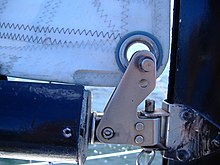Lout fitting
A lounger fitting is used to create a flexible connection between the mast and boom on dinghies and sailing yachts with sloping sails . This connection can be moved in two axes in order to adapt the sail to different wind directions.
The Lümmel fitting is actually a further development of the Lümmels , a bolt that z. B. of the large tree or in the case of loading trees made it possible to move. At that time it was often a hook-shaped iron in the shape of a gooseneck. The lout made it possible to turn the spar and raise and lower it.
The gooseneck is composed of a screwed or riveted to the mast fitting with two superposed eyelets (lout the bearings). These eyelets are connected with a thick bolt, onto which an intermediate piece is placed, around which the tree can later be rotated in a horizontal direction. At the intermediate piece there is another, horizontal, axis to which the tree is attached via the actual lout fitting. As a result, it can also be moved up and down, which is needed to compensate for different wind strengths. On the upper part there is another eyelet or a hook to which the neck of the (main) sail is attached .
The terminology is not entirely clear: Lümmel fitting is sometimes used to describe the fitting at the end of the boom, and sometimes the entire connection, which consists of at least six parts (bearing, spacer, boom fitting, two bolts and a hook for the sail; plus a safety device split pins and washers ).
See also
literature
- Joachim Schult: Sailors Lexicon . 13th edition. Delius Klasing Verlag, Bielefeld 2008, ISBN 978-3-7688-1041-8 , keywords Lümmel and Lümmel-Beschlag
